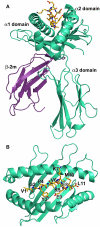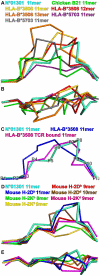MHC class I bound to an immunodominant Theileria parva epitope demonstrates unconventional presentation to T cell receptors
- PMID: 20976198
- PMCID: PMC2954893
- DOI: 10.1371/journal.ppat.1001149
MHC class I bound to an immunodominant Theileria parva epitope demonstrates unconventional presentation to T cell receptors
Abstract
T cell receptor (TCR) recognition of peptide-MHC class I (pMHC) complexes is a crucial event in the adaptive immune response to pathogens. Peptide epitopes often display a strong dominance hierarchy, resulting in focusing of the response on a limited number of the most dominant epitopes. Such T cell responses may be additionally restricted by particular MHC alleles in preference to others. We have studied this poorly understood phenomenon using Theileria parva, a protozoan parasite that causes an often fatal lymphoproliferative disease in cattle. Despite its antigenic complexity, CD8+ T cell responses induced by infection with the parasite show profound immunodominance, as exemplified by the Tp1(214-224) epitope presented by the common and functionally important MHC class I allele N*01301. We present a high-resolution crystal structure of this pMHC complex, demonstrating that the peptide is presented in a distinctive raised conformation. Functional studies using CD8+ T cell clones show that this impacts significantly on TCR recognition. The unconventional structure is generated by a hydrophobic ridge within the MHC peptide binding groove, found in a set of cattle MHC alleles. Extremely rare in all other species, this feature is seen in a small group of mouse MHC class I molecules. The data generated in this analysis contribute to our understanding of the structural basis for T cell-dependent immune responses, providing insight into what determines a highly immunogenic p-MHC complex, and hence can be of value in prediction of antigenic epitopes and vaccine design.
Conflict of interest statement
The authors have declared that no competing interests exist.
Figures





Similar articles
-
CD8 T-cell responses against the immunodominant Theileria parva peptide Tp249-59 are composed of two distinct populations specific for overlapping 11-mer and 10-mer epitopes.Immunology. 2016 Oct;149(2):172-85. doi: 10.1111/imm.12637. Epub 2016 Jul 25. Immunology. 2016. PMID: 27317384 Free PMC article.
-
Characterization of the fine specificity of bovine CD8 T-cell responses to defined antigens from the protozoan parasite Theileria parva.Infect Immun. 2008 Feb;76(2):685-94. doi: 10.1128/IAI.01244-07. Epub 2007 Dec 10. Infect Immun. 2008. PMID: 18070892 Free PMC article.
-
Systematic Determination of TCR-Antigen and Peptide-MHC Binding Kinetics among Field Variants of a Theileria parva Polymorphic CTL Epitope.J Immunol. 2022 Feb 1;208(3):549-561. doi: 10.4049/jimmunol.2100400. Epub 2022 Jan 14. J Immunol. 2022. PMID: 35031580 Free PMC article.
-
Designing bovine T cell vaccines via reverse immunology.Ticks Tick Borne Dis. 2012 Jun;3(3):188-92. doi: 10.1016/j.ttbdis.2011.12.001. Epub 2012 Jan 9. Ticks Tick Borne Dis. 2012. PMID: 22621863 Review.
-
Revealing factors determining immunodominant responses against dominant epitopes.Immunogenetics. 2020 Feb;72(1-2):109-118. doi: 10.1007/s00251-019-01134-9. Epub 2019 Dec 6. Immunogenetics. 2020. PMID: 31811313 Free PMC article. Review.
Cited by
-
Constraints on haplotype structure and variable gene frequencies suggest a functional hierarchy within cattle MHC class I.Immunogenetics. 2012 Jun;64(6):435-45. doi: 10.1007/s00251-012-0612-6. Epub 2012 Mar 28. Immunogenetics. 2012. PMID: 22454046
-
Identification of Theileria lestoquardi Antigens Recognized by CD8+ T Cells.PLoS One. 2016 Sep 9;11(9):e0162571. doi: 10.1371/journal.pone.0162571. eCollection 2016. PLoS One. 2016. PMID: 27611868 Free PMC article.
-
Molecular Dynamics Simulation Reveals the Selective Binding of Human Leukocyte Antigen Alleles Associated with Behçet's Disease.PLoS One. 2015 Sep 2;10(9):e0135575. doi: 10.1371/journal.pone.0135575. eCollection 2015. PLoS One. 2015. PMID: 26331842 Free PMC article.
-
Complex assembly, crystallization and preliminary X-ray crystallographic analysis of the bovine CD8αα-BoLA-2*02201 complex.Acta Crystallogr F Struct Biol Commun. 2014 Jun;70(Pt 6):742-6. doi: 10.1107/S2053230X14008838. Epub 2014 May 10. Acta Crystallogr F Struct Biol Commun. 2014. PMID: 24915083 Free PMC article.
-
Cattle MHC nomenclature: is it possible to assign sequences to discrete class I genes?Immunogenetics. 2012 Jun;64(6):475-80. doi: 10.1007/s00251-012-0611-7. Epub 2012 Mar 15. Immunogenetics. 2012. PMID: 22419150
References
-
- Townsend ARM, Gotch FM, Davey J. Cytotoxic T cells recognize fragments of the influenza nucleoprotein. Cell. 1985;42:457–467. - PubMed
-
- Davis MM, Bjorkman PJ. A model for T cell receptor and MHC/peptide interaction. Adv Exp Med Biol. 1989;254:13–16. - PubMed
-
- Bjorkman PJ, Parham P. Structure, function and diversity of class I MHC molecules. Ann Rev Biochem. 1990;59:253–288. - PubMed
-
- Holmes EC, Roberts AFC, Staines KA, Ellis SA. Evolution of MHC class I genes in Cetartiodactyls. Immunogenetics. 2003;55:193–202. - PubMed
-
- Birch J, Murphy L, MacHugh ND, Ellis SA. Generation and maintenance of diversity in the cattle MHC class I region. Immunogenetics. 2006;58:670–679. - PubMed
Publication types
MeSH terms
Substances
Grants and funding
LinkOut - more resources
Full Text Sources
Other Literature Sources
Research Materials

